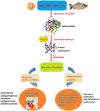Bioactive peptides of marine organisms: Roles in the reduction and control of cardiovascular diseases
- PMID: 39139935
- PMCID: PMC11317662
- DOI: 10.1002/fsn3.4183
Bioactive peptides of marine organisms: Roles in the reduction and control of cardiovascular diseases
Abstract
Cardiovascular diseases (CVDs) affect the quality of life or are fatal in the worst cases, resulting in a significant economic and social burden. Therefore, there is an urgent need to invent functional products or drugs for improving patient health and alleviating and controlling these diseases. Marine bioactive peptides reduce and control CVDs. Many of the predisposing factors triggering CVDs can be alleviated by consuming functional foods containing marine biopeptides. Therefore, improving CVD incidence through the use of effective biopeptide foods from marine sources has attracted increasing interest and attention. This review reports information on bioactive peptides derived from various marine organisms, focusing on the process of the separation, purification, and identification of biological peptides, biological characteristics, and functional food for promoting cardiovascular health. Increasing evidence shows that the bioactivity and safety of marine peptides significantly impact their storage, purification, and processing. It is feasible to develop further strategies involving functional foods to treat CVDs through effective safety testing methods. Future work should focus on producing high-quality marine peptides and applying them in the food and drug industry.
Keywords: anticoagulant activity; antihypertensive activity; bioactive peptides; cardiovascular diseases; functional food; marine organisms.
© 2024 The Authors. Food Science & Nutrition published by Wiley Periodicals LLC.
Conflict of interest statement
The authors declare that they do not have any conflict of interest.
Figures
References
-
- Admassu, H. , Gasmalla, M. A. A. , Yang, R. , & Zhao, W. (2018). Bioactive peptides derived from seaweed protein and their health benefits: Antihypertensive, antioxidant, and antidiabetic properties. Journal of Food Science, 83(1), 6–16. - PubMed
-
- Ahn, C. B. , Jeon, Y. J. , Kim, Y. T. , & Je, J. Y. (2012). Angiotensin I converting enzyme (ACE) inhibitory peptides from Salmon byproduct protein hydrolysate by Alcalase hydrolysis. Process Biochemistry, 47(12), 2240–2245.
-
- Betoret, E. , Betoret, N. , Vidal, D. , & Fito, P. (2011). Functional foods development: Trends and technologies. Trends in Food Science & Technology, 22(9), 498–508.
-
- Cai, W. W. , Hu, X. M. , Wang, Y. M. , Chi, C. F. , & Wang, B. (2022). Bioactive peptides from skipjack tuna cardiac arterial bulbs: Preparation, identification, antioxidant activity, and stability against thermal, pH, and simulated gastrointestinal digestion treatments. Marine Drugs, 20, 626. - PMC - PubMed
-
- Cermeno, M. , Stack, J. , & Tobin, P. R. (2019). Peptide identification from a Porphyra dioica protein hydrolysate with antioxidant, angiotensin converting enzyme and dipeptidyl peptidase IV inhibitory activities. Food & Function, 10(6), 3421–3429. - PubMed
Publication types
LinkOut - more resources
Full Text Sources



